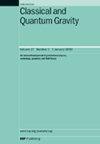从存在伪影的LISA数据中提取引力波信号
IF 3.7
3区 物理与天体物理
Q2 ASTRONOMY & ASTROPHYSICS
引用次数: 0
摘要
激光干涉仪空间天线(LISA)任务是由ESA开发的,NASA也参与其中。由于它最近通过了任务采用里程碑,仪器和噪声性能的模型变得更加详细,同样原型数据分析也必须如此。假设,如高斯性、平稳性和数据连续性是不现实的,必须用物理动机的数据模拟和数据分析方法来取代,以适应这种可能的缺陷。为此,LISA数据挑战产生了具有时变和不等星座臂长的数据集,以及包括数据中断和仪器瞬变在内的测量伪影。在这项工作中,我们评估了这些数据伪影对银河系双星和大质量黑洞性质推断的影响。我们的分析表明,噪声瞬态和间隙的处理对于有效的参数估计是必要的,因为如果不加以缓解,它们会严重破坏分析。我们发现直接的缓解技术可以显著地(如果不完全地)抑制伪影。对于银河双星,对故障的缓解基本上是全面的,而对数据差距的缓解使参数的不确定性增加了大约10%。对于大质量黑洞双星来说,特别有害的小故障导致在缓解后不确定性增加30%,而数据缺口可以使参数不确定性增加几倍。至关重要的是,这强调了早期探测瞬态引力波的重要性,以确保它们免受计划中的数据中断。本文章由计算机程序翻译,如有差异,请以英文原文为准。
Extracting gravitational wave signals from LISA data in the presence of artifacts
The Laser Interferometer Space Antenna (LISA) mission is being developed by ESA with NASA participation. As it has recently passed the Mission Adoption milestone, models of the instruments and noise performance are becoming more detailed, and likewise prototype data analyses must as well. Assumptions such as Gaussianity, stationarity, and data continuity are unrealistic, and must be replaced with physically motivated data simulations, and data analysis methods adapted to accommodate such likely imperfections. To this end, the LISA Data Challenges have produced datasets featuring time-varying and unequal constellation armlength, and measurement artifacts including data interruptions and instrumental transients. In this work, we assess the impact of these data artifacts on the inference of galactic binary and massive black hole properties. Our analysis shows that the treatment of noise transients and gaps is necessary for effective parameter estimation, as they substantially corrupt the analysis if unmitigated. We find that straightforward mitigation techniques can significantly if imperfectly suppress artifacts. For the Galactic Binaries, mitigation of glitches was essentially total, while mitigations of the data gaps increased parameter uncertainty by approximately 10%. For the massive black hole binaries the particularly pernicious glitches resulted in a 30% uncertainty increase after mitigations, while the data gaps can increase parameter uncertainty by up to several times. Critically, this underlines the importance of early detection of transient gravitational waves to ensure they are protected from planned data interruptions.
求助全文
通过发布文献求助,成功后即可免费获取论文全文。
去求助
来源期刊

Classical and Quantum Gravity
物理-天文与天体物理
CiteScore
7.00
自引率
8.60%
发文量
301
审稿时长
2-4 weeks
期刊介绍:
Classical and Quantum Gravity is an established journal for physicists, mathematicians and cosmologists in the fields of gravitation and the theory of spacetime. The journal is now the acknowledged world leader in classical relativity and all areas of quantum gravity.
 求助内容:
求助内容: 应助结果提醒方式:
应助结果提醒方式:


